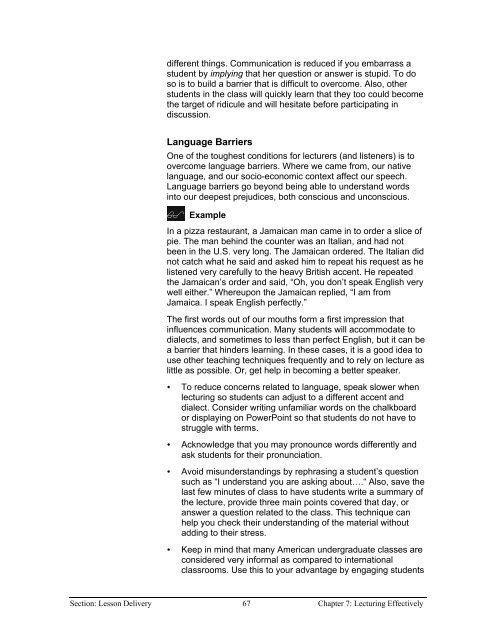Chapter 9 - Instructional Media: Chalkboards to Video - CGISS
Chapter 9 - Instructional Media: Chalkboards to Video - CGISS
Chapter 9 - Instructional Media: Chalkboards to Video - CGISS
You also want an ePaper? Increase the reach of your titles
YUMPU automatically turns print PDFs into web optimized ePapers that Google loves.
different things. Communication is reduced if you embarrass a<br />
student by implying that her question or answer is stupid. To do<br />
so is <strong>to</strong> build a barrier that is difficult <strong>to</strong> overcome. Also, other<br />
students in the class will quickly learn that they <strong>to</strong>o could become<br />
the target of ridicule and will hesitate before participating in<br />
discussion.<br />
Language Barriers<br />
One of the <strong>to</strong>ughest conditions for lecturers (and listeners) is <strong>to</strong><br />
overcome language barriers. Where we came from, our native<br />
language, and our socio-economic context affect our speech.<br />
Language barriers go beyond being able <strong>to</strong> understand words<br />
in<strong>to</strong> our deepest prejudices, both conscious and unconscious.<br />
Example<br />
In a pizza restaurant, a Jamaican man came in <strong>to</strong> order a slice of<br />
pie. The man behind the counter was an Italian, and had not<br />
been in the U.S. very long. The Jamaican ordered. The Italian did<br />
not catch what he said and asked him <strong>to</strong> repeat his request as he<br />
listened very carefully <strong>to</strong> the heavy British accent. He repeated<br />
the Jamaican’s order and said, “Oh, you don’t speak English very<br />
well either.” Whereupon the Jamaican replied, “I am from<br />
Jamaica. I speak English perfectly.”<br />
The first words out of our mouths form a first impression that<br />
influences communication. Many students will accommodate <strong>to</strong><br />
dialects, and sometimes <strong>to</strong> less than perfect English, but it can be<br />
a barrier that hinders learning. In these cases, it is a good idea <strong>to</strong><br />
use other teaching techniques frequently and <strong>to</strong> rely on lecture as<br />
little as possible. Or, get help in becoming a better speaker.<br />
• To reduce concerns related <strong>to</strong> language, speak slower when<br />
lecturing so students can adjust <strong>to</strong> a different accent and<br />
dialect. Consider writing unfamiliar words on the chalkboard<br />
or displaying on PowerPoint so that students do not have <strong>to</strong><br />
struggle with terms.<br />
• Acknowledge that you may pronounce words differently and<br />
ask students for their pronunciation.<br />
• Avoid misunderstandings by rephrasing a student’s question<br />
such as “I understand you are asking about….“ Also, save the<br />
last few minutes of class <strong>to</strong> have students write a summary of<br />
the lecture, provide three main points covered that day, or<br />
answer a question related <strong>to</strong> the class. This technique can<br />
help you check their understanding of the material without<br />
adding <strong>to</strong> their stress.<br />
• Keep in mind that many American undergraduate classes are<br />
considered very informal as compared <strong>to</strong> international<br />
classrooms. Use this <strong>to</strong> your advantage by engaging students<br />
in discussions about your <strong>to</strong>pic. Students are likely <strong>to</strong><br />
appreciate your willingness <strong>to</strong> involve them and will help<br />
Section: Lesson Delivery offset any difficulties 67 with the language. <strong>Chapter</strong> 7: Lecturing Effectively
















